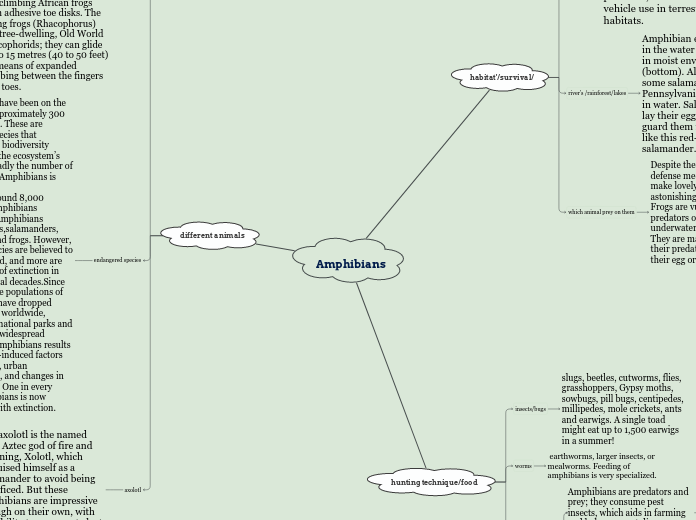Amphibians
habitat'/survival/
dangers
Habitat loss and degradation is one of the greatest threats to amphibian and reptile populations and occurs from a variety of sources, including urban/suburban development, aquatic habitat alteration from water withdrawals and stream diversions, water pollution, and off-road vehicle use in terrestrial habitats.
river's /rainforest/lakes
Amphibian eggs can be laid in the water (top) or on land in moist environments (bottom). All frogs and some salamanders in Pennsylvania lay their eggs in water. Salamanders that lay their eggs on land often guard them from predators, like this red-backed salamander.
which animal prey on them
Despite their incredible defense mechanisms, frogs make lovely meals for an astonishing array of wildlife. Frogs are vulnerable to predators on the ground, underwater, and from above. They are mainly defenseless to their predators while still in their egg or tadpole stages.
hunting technique/food
insects/bugs
slugs, beetles, cutworms, flies, grasshoppers, Gypsy moths, sowbugs, pill bugs, centipedes, millipedes, mole crickets, ants and earwigs. A single toad might eat up to 1,500 earwigs in a summer!
worms
earthworms, larger insects, or mealworms. Feeding of amphibians is very specialized.
ways they hunt
Amphibians are predators and prey; they consume pest insects, which aids in farming and helps prevent disease transmission.
Occupation
l
All adult amphibians are meat-eating predators. Their prey includes insects, slugs, worms, and even small mammals, such as mice. Aquatic amphibians eat water snails, insects, and small fish. Many amphibians hunt at night, using their sharp sight, smell, and hearing to track victims.
different animals
frogs
In general, frogs have protruding eyes, no tail, and strong, webbed hind feet that are adapted for leaping and swimming. They also possess smooth, moist skins. Many are predominantly aquatic, but some live on land, in burrows, or in trees. A number depart from the typical form. Sedge frogs (Hyperolius), for example, are climbing African frogs with adhesive toe disks. The flying frogs (Rhacophorus) are tree-dwelling, Old World rhacophorids; they can glide 12 to 15 metres (40 to 50 feet) by means of expanded webbing between the fingers and toes.
endangered species
Amphibians have been on the planet for approximately 300 million years. These are intriguing species that contribute to biodiversity balance and the ecosystem’s health, but sadly the number of Endangered Amphibians is increasing.
There are around 8,000 species of Amphibians worldwide. Amphibians include newts,salamanders, caecilians, and frogs. However, over 120 species are believed to have vanished, and more are on the verge of extinction in the last several decades.Since the 1950s, the populations of amphibians have dropped substantially worldwide, including in national parks and forests. This widespread decrease of amphibians results from human-induced factors from logging, urban development, and changes in their habitat. One in every three amphibians is now threatened with extinction.
axolotl
the axolotl is the named after Aztec god of fire and lightning, Xolotl, which disguised himself as a salamander to avoid being sacrificed. But these amphibians are impressive enough on their own, with the ability to regenerate lost limbs and stay “young” throughout their lives.
